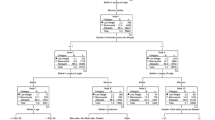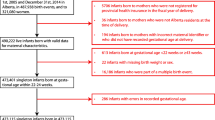Abstract
Low birth weight (LBW) is a global problem that annually affects nearly 20 million children, 96% of these in developing countries. According to the WHO, the poorest and the ethnic minorities are the groups most affected by this indicator. A cross-sectional study of the database of all newborns officially registered in Colombia in 2008–2014 was done. While dichotomizing the mestizo population and ethnic minorities (Afro-descendants, indigenous, ROM), normal and low birth weight was used as the dependent variable and ethnicity as the explanatory variable. Other variables of the parents and the newborns were used as covariates. To assess associations, bivariate and multivariate logistic regression analyses were performed. The incidence of LBW among newborns registered in Colombia fluctuated at around 9%. Among the ethnic minorities, the probability of LBW, adjusted for other variables, was significantly higher (OR 1.07, 95% CI 1.05–1.08) than among mestizos. A significantly higher risk of LBW to newborns in the ethnic minorities’ group, and those with unfavorable socioeconomic conditions, was found
Resumen
El bajo peso al nacer (BPN) es un problema global que afecta anualmente a casi 20 millones de niños, el 96% de estos en países en desarrollo. Según la OMS, las más pobres y las minorías étnicas son los grupos más afectados por este indicador. Se realizó un estudio transversal de la base de datos de todos los recién nacidos registrados oficialmente en Colombia en 2008-2014. La población fue dicotomizaba en mestiza y minorías étnicas (afrodescendientes, indígenas, ROM). Se utilizó Bajo Peso al Nacer (BPN) como variable dependiente y el origen étnico como variable explicativa. Otras variables de los padres y los recién nacidos se utilizaron como covariables. Para evaluar las asociaciones, se realizaron análisis de regresión logística bivariada y multivariada. La incidencia de BPN entre los recién nacidos registrados en Colombia fluctuó alrededor del 9%. Entre las minorías étnicas, la probabilidad de LBW, ajustada por otras variables, fue significativamente mayor (OR = 1.07, 95% _CI: 1.05-1.08) que entre los mestizos. Se encontró un riesgo significativamente más alto de BPN para los recién nacidos en el grupo de minorías étnicas y aquellos con condiciones socioeconómicas desfavorables.
Similar content being viewed by others
References
World Health Organization. Alimentación de lactantes con bajo peso al nacer. Geneva: World Health Organization; 2017.
World Health Organization. Cerrando la Brecha: La política de Acción sobre los Determinantes Sociales de la Salud. Geneva: WHO; 2011.
United Nations Children’s Fund. Health equity report 2016. New York: United Nations Children’s Fund; 2016.
World Health Organization. Reducir la mortalidad de los recién nacidos. Geneva: World Health Organization; 2016.
World Health Organization. Nacidos Demasiado Pronto: Informe de Acción Global sobre Nacimientos Prematuros. Geneva: WHO; 2015.
World Health Organization. A conceptual framework for action on the social determinants of health. Social Determinants of Health Discussion Paper 2. Geneva: WHO; 2010.
World Health Organization. Estrategia Mundial para la Salud de la Mujer, el Niño y el Adolescente (2016–2030). Geneva: World Health Organization; 2016.
National Administrative Department of Statistics. Archivo nacional de datos. Microdatos DANE. [Internet]. [citado 9 de agosto de 2016]. Disponible en: https://formularios.dane.gov.co/Anda_4_1/index.php/catalog/microdatos.
Alwin D. In: Symposium on the life course constructing lives and de-constructing the life course, 2014.
Bello A, Rangel M. Etnicidad, raza y equidad en América Latina y el Caribe. 8 de marzo de. Santiago: United Nations Economic Commission for Latin America and the Caribbean; 2000.
Constitución Política de Colombia. No. 116 de 20 de julio de 1991 [Internet]. [citado 6 de mayo de 2016]. Disponible en: https://www.secretariasenado.gov.co/senado/basedoc/constitucion_politica_1991.html.
Organización Panamericana de la Salud. Manual para el Monitoreo de las Inequidades en Salud, con especial énfasis en países de ingresos medianos y bajos. Washington, DC: Organización Panamericana de la Salud; 2016.
Márquez Beltrán MFR, Vargas Hernández JE, Quiroga Villalobos EF, Pinzón Villate GY. An analysis of low birth weight in Colombia, 2005–2009. Rev Salud Publica Bogota Colomb. 2013;15(4):577–88.
Organizacion Panamericana de la Salud. Equidad en salud para las minorías étnicas en Colombia. Washington, DC: Organización Panamericana de la Salud; 2007.
Nyarko KA, López Camelo J, Castilla EE, Wehby GL. Explicación de las disparidades raciales en la salud neonatal en Brasil. Am J Public Health. 2015;105(S4):S563–S574574.
Collins JW, David RJ. Racial disparity in low birth weight and infant mortality. Clin Perinatol. 2009;36(1):63–73.
Programa de las Naciones Unidas para el desarrollo. Colombia rural Razones para la esperanza Razones para la esperanza. New York: Programa de las Naciones Unidas para el desarrollo; 2011.
World Health Organization. Declaración de la OMS sobre tasas de cesárea. Geneva: WHO; 2017.
Ministerio de Salud y Protección Social. Asociación Probienestar de la Familia Colombiana Profamilia Encuesta Nacional de Demografía y Salud 2010. Bogota: Ministerio de la Protección Social República de Colombia; 2011.
Ribeiro VS, Silva AA. Neonatal mortality trends in São Luís, Maranhão, Brazil, from 1979 to 1996. Cad Saude Publica. 2000;16(2):429–38.
Barros FC, Victora CG, Barros AJ, Santos IS, Albernaz E, Matijasevich A, et al. The challenge of reducing neonatal mortality in middle-income countries: findings from three Brazilian birth cohorts in 1982, 1993, and 2004. Lancet. 2005;365(9462):847–54.
Bortman M. Risk factors for low birth weight. Rev Panam Salud Publica Pan Am J Public Health. 1998;3(5):314–21.
Demelash H, Motbainor A, Nigatu D, Gashaw K, Melese A. Risk factors for low birth weight in Bale zone hospitals, South-East Ethiopia : a case–control study. BMC Pregnancy Childbirth. 2015;15(1):264.
Victora C, Matijasevich A, Silveira M, Santos I, Barros A, Barros F. Socio-economic and ethnic group inequities in antenatal care quality in the public and private sector in Brazil. Health Policy Plan. 2010;25(4):253–61.
Restrepo Mesa S, Zapata N, Parra B, Escudero L, Atalah E. Embarazo en la adolescencia: características maternas y su asociación con el peso al nacer del recién nacido. Arch Latinoam Nutr. 2014;2(64):99–107.
Kent ST, McClure LA, Zaitchik BF, Gohlke JM. Area-level risk factors for adverse birth outcomes: trends in urban and rural settings. BMC Pregnancy Childbirth. 2013;13(1):129.
Shapiro GD, Bushnik T, Sheppard AJ, Kramer MS, Kaufman JS, Yang S. Paternal education and adverse birth outcomes in Canada. J Epidemiol Commun Health. 2017;71(1):67–72.
World Health Organization. Nacimientos prematuros. Geneva: WHO; 2016.
Instituto Nacional de Salud. Vigilancia y Control en Salud Pública. Bajo peso al nacer a término. Bogota: Instituto Nacional de Salud; 2017.
Mosquera-Becerra J. Unveiling what is said in the colombian public health journals about race and ethnicity. Univ Val Cali Colomb. 2015;16:1–21.
Departamento Administrativo Nacional de Estadística. Minprotección Social. Estudio La mortalidad materna y perinatal en Colombia en los albores del siglo XXI. Bogota: Departamento Administrativo Nacional de Estadística; 2006.
Asociación Probienestar de la Familia Colombiana. Encuesta Nacional de Demografía y Salud 2015. Bogato: Asociación Probienestar de la Familia Colombiana; 2015.
Ojeda G, Ordoñez M, Ochoa L. Encuesta Nacional de Demografìa y Salud—ENDS-2010. Quezon City: National Demographic and Health Survey; 2011.
Acknowledgements
IA and VS were supported by a research grant of the Colombian Administrative Agency of Science, Technology and Innovation—COLCIENCIAS, currently Ministry of Science (funding agreement for research 889/2015, cod. 111572553299).
Funding
The authors gratefully thank to Prof. Ruben-Dario Gomez-Arias for his advice and helpfulness.
Author information
Authors and Affiliations
Corresponding author
Additional information
Publisher's Note
Springer Nature remains neutral with regard to jurisdictional claims in published maps and institutional affiliations.
Rights and permissions
About this article
Cite this article
Sierra-Rodríguez, VL., Cardona-Arango, D. & Arroyave, I. Ethnicity and Low Birth Weight: Inequalities Between Ethnic Minorities and the Predominant Mestizo Population, Colombia, 2008–2014. J Immigrant Minority Health 23, 62–70 (2021). https://doi.org/10.1007/s10903-020-01031-4
Published:
Issue Date:
DOI: https://doi.org/10.1007/s10903-020-01031-4




